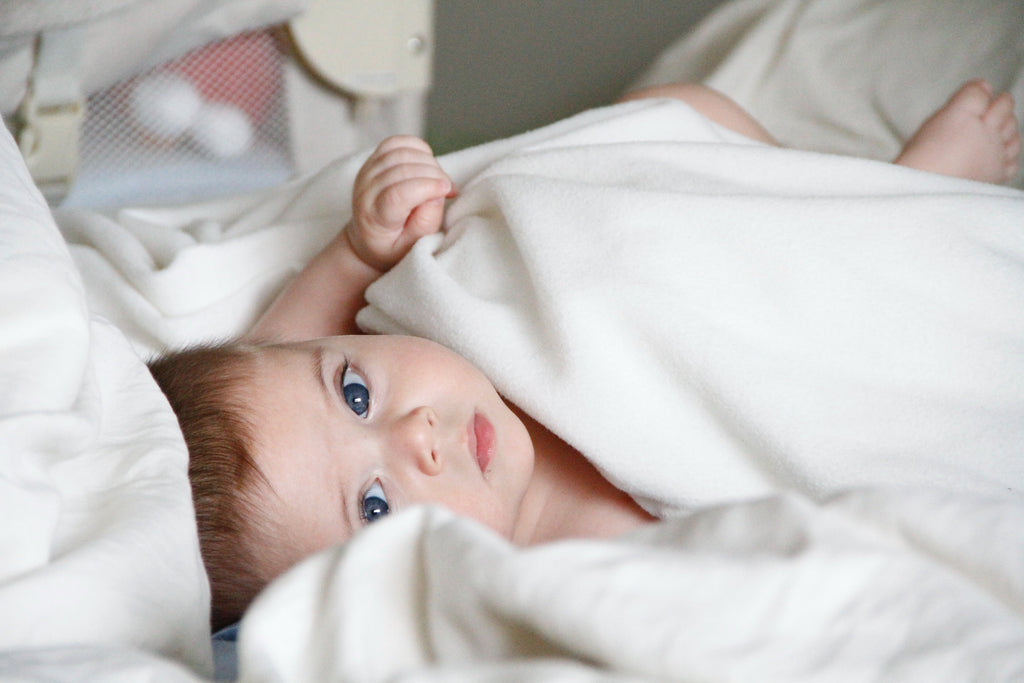Ensuring your baby sleeps safely and soundly can feel overwhelming as a parent, and yet, it’s your top priority. With the array of choices and sleep sack sizing concerns, how can you feel confident in choosing a sleep sack? How should a sleep sack fit?
We’ve made it simple at Nested Bean to take the guesswork out of selecting the perfect sleep sack for your little one. Our guide promises peace of mind, offering clear insights and supportive advice to make sure your baby’s comfort is matched only by your confidence in their well-being.
Before we help you find the right-sized sleep sack, let’s discuss the importance of proper sleep sack sizing in the first place.
The Importance of Proper Sleep Sack Sizing
Selecting the correct sleep sack size isn’t just about comfort – it’s a critical safety choice for your infant. You want to reap the benefits of sleep sack without putting your child at risk of problems like SIDS.
An oversized sleep sack can pose a risk as it might ride up and cover your baby’s face, impeding their ability to breathe. Conversely, a sack that’s too small can restrict their natural movement and development.
The good news? All this can be avoided with our sleep sack size guide! Here’s why how to dress newborn for sleep shouldn’t be taken lightly…
The Role of Sleep Sack Size in Preventing SIDS
Sudden Infant Death Syndrome (SIDS) remains a leading concern for parents, and proper sleep sack sizing contributes to a safer sleep environment.
A well-fitting sleep sack minimizes the risk of loose fabric in the crib, which is a factor associated with SIDS. It’s crucial to ensure that the sleep sack fits snugly around the chest and shoulders with no excess material around the neck.
How the Right Fit Promotes Better Sleep
Beyond safety, the right sleep sack fit supports your newborn sleep schedule or baby nap schedule. Babies often sleep more soundly when they feel secure without being constrained.
The correct-sized sleep sack offers a cocoon-like environment that soothes without limiting their ability to stretch and move comfortably.
While the swaddle transition can often be a cause of sleep regression, you can size your sleep sack to perfection and avoid problems with your baby fighting sleep as you take their weighted baby swaddle out of the equation!
Sleep Sack Size and Baby’s Development
Your baby’s sleep sack needs will evolve as they grow and reach new developmental milestones. The right size supports their growing bodies while accommodating increased activity, like rolling over and kicking.
It’s essential to transition sizes at the appropriate times to foster their physical development and continued sleep safety. That being said, how should a sleep sack fit?
So, How Should a Sleep Sack Fit?
Understanding the fitting of a sleep sack is critical to both the safety and comfort of your baby. It should fit snugly around the chest and neck without being constricting, ensuring that there’s no risk of it riding up over the baby’s face.
The armholes should be the right size to prevent the baby from slipping inside the sack, yet allow freedom of movement. A sleep sack should provide ample space for hip and leg movement, which is crucial for proper hip development.
At the same time, it shouldn’t be so long that there’s excessive fabric bunched around the baby’s feet. This balance is where comfort meets safety – your baby has the freedom to wriggle and grow, while you have the peace of mind that they’re sleeping safely.
You’re investing in the premier weighted sleepwear when you choose a Nested Bean sleep sack. You’re choosing a carefully designed companion that aligns with your baby’s growth and movements, keeping them secure and cozy throughout the night.
Rest assured that your baby’s sleep sack will fit them just right, from the neckline down to the bottom hem when you get your weighted sleep sack at Nested Bean! We’ll offer more tips below.
Tips on Figuring Out What Size Sleep Sack for Baby Is Ideal
Knowing how a sleep sack should fit in general is key to keeping your child healthy and happy. And we’ve made it easier than ever to figure out what size sleep sack for baby you need.
So, how should a sleep sack fit across different ages? Our sleep sack size guide makes this super simple:
For Infants (0-6 Months):
- Weight: The Zen Sack™ should accommodate infants weighing between 7-18 lbs. It’s essential not to place a baby under 7 lbs in a 0-6M sack, as it could be too spacious and pose a safety risk.
- Length: The sack is designed for infants with a length of 21-30 inches. A proper fit allows for healthy movement, while ensuring the sack isn’t too long and the baby can’t slip inside.
For Older Babies (6-15 Months):
- Weight: Opt for this size when your baby weighs between 16-26 lbs. The design considers babies who may start to roll and move more during sleep, providing enough room for activity without being restrictive.
- Length: Aim for a length fit of 26-33 inches. This ensures the Zen Sack™ extends no further than the baby’s feet, allowing for safe and comfortable stretching.
For Toddlers (15-24 Months):
- Weight: This size is ideal for toddlers weighing between 26-36 lbs. It provides enough space for growing toddlers, giving them comfort without constraining their movements during sleep.
- Length: The sack suits toddlers with a length of 31-38 inches. It should reach just below the toddler’s feet, ensuring it does not ride up around the face.
Other Sleep Sack Considerations Beyond Sizing
Parents often measure their success by the comfort and safety they provide for their children. The stakes are even higher when it comes to their rest.
You’ve tackled sleep sack sizing, but let’s navigate the less discussed, yet equally critical aspects of choosing a sleep sack that serves your child’s needs through every yawn and stretch.
Material Matters: Weight and TOG Ratings
The fabric enveloping your little one matters as much as the embrace you give them. The weight of the material is a delicate balance – too heavy, and your child might overheat. Too light, and they may not feel snug. Our sleep sacks are crafted with this in mind, featuring materials that breathe and adapt.
Then there’s the TOG rating, a scale that measures thermal resistance. It’s not just jargon; it’s about understanding how the sleep sack will function in tandem with the room temperature. A higher TOG is perfect for cooler environments, cradling your child in warmth.
Conversely, a lower TOG allows for airiness in warmer settings. With our products, you’ll find the ratings clearly indicated because we know it’s about making informed choices for your child’s comfort.
For example, our winter sleep sack is heavier and perfect for keeping your child guarded against chilly winter evenings. On the other hand, our bamboo rayon fabric sleep sack is much lighter and more breathable – perfect for those hot summer evenings.
Design Features for Functionality
Every zip, snap, and fold on a sleep sack is there for a reason. Does it have a double zipper for effortless diaper changes? Are the armholes and neck opening adjustable for your growing child?
These details are functional features designed to simplify your life while keeping your baby’s comfort at the forefront. Your sleep sack of choice should make your life simpler as a parent.
Choosing the Right Sleep Sack for Different Stages
Your child’s journey from newborn to toddler is a cascade of growth and change. A sleep sack suitable for a newborn might not serve the active needs of a toddler. At Nested Bean, we curate our collection to accompany your child through each milestone.
From the gentle weight that mimics a parent’s touch in our newborn sacks to the freedom of movement in our toddler selections, our range considers the developmental needs of each stage.
You can learn more about the magic of sleep sacks in our blog. We have resources on topics like what to wear under sleep sack, the purpose of sleep sack, swaddle vs sleep sack, when to stop using sleep sack, transitioning from sleep sack to blanket, and more. At this point, though, it’s time to bring our sleep sack sizing guide to a close.
Wrapping Up Our Sleep Sack Sizing Guide
So, how should a sleep sack fit? As we wrap up our guide to sizing a sleep sack we hope you feel a lot more confident in choosing the perfect size for your newborn baby.
We’ve also discussed how material, TOG ratings, and design can profoundly influence your child’s comfort and safety during sleep. If you struggle with your newborn not sleeping, a Nested Bean sleep sack is here to help baby sleep through the night.
You can learn more about when can babies sleep in their own room, cosleeping, why swaddle baby, types of swaddles, baby cries meaning, sleep training newborn babies, when do toddlers stop napping, baby separation anxiety, 6 month sleep regression, 10 month old sleep schedule, and more.
Now that you’re ready, wrap your little one in the embrace of a Nested Bean sleep sack. Trust in our expertise to guide your choice, and feel the difference tonight. Shop with us today and embrace the serenity of a good night’s sleep, for your child and for you.








